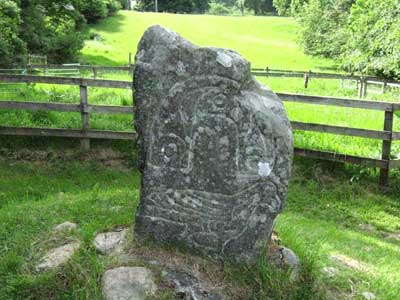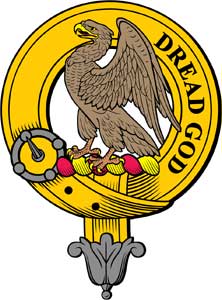Near the highland town of Dingwall sits the village of Strathpeffer, A collection of attractive houses. surrounded by impressive mature trees. A quaint victorian railway station, no longer used, gives away the village’s past as a popular spa destination – the nearby grand old hotel is another sign of a now faded glory.

Nestling among the houses on a quiet hillside there is a small fenced off patch of grass, in the centre a modest standing stone with ancient carvings – this is the famous ‘Eagle Stone’, also known as the Clach an Tiompain or ‘Sounding Stone’
The stone is featured in one notable prophesy by the Brahan Seer – he foresaw a great tragedy that would befall the area should the stone topple over three times, over the years it has been known to have fallen twice and superstitious locals have ensured it moves no more by cementing it in place.
Local legends have claimed the stone was erected after a skirmish between the Clan Munro and the MacDonalds of the Isles on the way to the battle of Harlaw in 1411 – a sort of practice friendly on the way to the knockout stages. Recent evidence has proven it to be much older though.
Although almost certainly Pictish in origin one famous folk tale links the stone again to Clan Munro, who’s crest symbol also depicts an eagle, the Eagle of Foulis.
On a high ridge on the other side of the valley lies the remains of an iron age fort known as Knockfarrel (literally ’stone fort’). The very first chief of Clan Munro lived here as the clan established its presence in the area. Around the fortification a small village or ‘clachan’ grew. The valley has lush farmland, ideal for grazing and growing all manner of crops, sheltered from the worst of the weather.
Knockfarrel is easily approached via a gently sloping trail up the side of the ridge but treacherous cliffs fall steeply away to one side – high on a rocky pinnacle in these cliffs a great eagle had made its nest. whether the Munro clan took their symbol from this eagle or it was just a remarkable coincidence we do not know but the clansmen saw the eagle as a good omen and were happy to share the valley with this magnificent creature. Even when the bird would lift a young lamb or goat kid they would take this as just an acceptable loss and the chief forbade anyone from doing harm to the eagle.
All was peaceful in the valley until one summers evening. It had been a beautiful day and the womenfolk worked preparing the evening meals and sewing. The children laughed and played between the small houses, outside one house towards the edge of the village one small boy sat, Lachlan, barely a toddler he rested on the grass and watched as his mother busied herself around him.
All at once a great dark shadow was cast across the valley and a terrible screeching was heard, In a blur of feathers and claws the huge eagle swooped down from its nest and caught the poor child in its massive talons. Before anyone could react he lifted the boy high into the air and carried him up the cliffside.
The cries of alarm went up throughout the village and the wailing of the grief stricken mother alerted young Hugh, the chieftain of the clan. When Hugh arrived at the scene he realised that he had to act and act quickly. He called for a length of rope and set off up the cliffside in pursuit. Not entirely sure what he would face when he reached the pinnacle.
Higher and higher Hugh clambered up the sheer face, as the village fell away below he heard a beating of wings and a rush of air – the great eagle was bearing down upon him. Holding onto the rope for dear life he tried to fend off the angry bird. The eagle soared away again and Hugh pressed on. In the fading light he caught a glimpse of a tangle of branches above him and with one last effort he hauled himself up and into the eagles nest.
Lying in the centre of the nest lay baby Lachlan. cooing away to himself as if nothing had happened. Hugh was relived that the boy despite his ordeal had barely a scratch on him but he realised that the hardest work lay ahead. No sooner had this thought crossed his mind than the huge eagle appeared again – even angrier than before. Hugh grabbed a large branch and swinging it like a club tried to fend it off, time and time again the eagle pecked and clawed and Hugh soon became exhausted. His clothes torn and his body bruised and bloody from the ferocious attack.
All this time little Lachlan laughed away thinking it no more than a silly game for his own amusement.

As the eagle made one more pass Hugh decided on an other tactic; he ducked under the thrashing wings and grabbed at the birds legs. Unsettling the creature just for a second he was able to pull it towards the nest and turn it over onto its back. With the advantage of surprise he reached up and got hold of the bird by the throat and squeezed with all his might.
Gradually the bird began to loose its grip on life, the struggle began to die and with one last effort Hugh squeezed the life from the mighty creature.
Meanwhile far below the cliff the villagers looked up, not knowing if the poor boy or Hugh for that matter were alive or dead. They had heard the terrifying shrieks of the bird and feared the worst. Then suddenly the distant figure of Hugh appeared, holding the corpse of this massive Eagle in his hand. They cheered and shouted and Hugh tossed the bird down, A gust of wind caught the feathers and the eagle’s broken body wheeled and glided down to the valley below, coming to rest at the edge of the village. Where the eagle fell the villagers placed a stone – the Eagle stone in recognition of the brave deeds of their chief and from respect to the noble creature that was such a powerful symbol of their clan.

I noticed that you spelled McDonald as Mc rather than Mac. Is that on purpose? As far back as I can trace our family the name was spelled Mc and we came to Canada in 1825 from Benbecula. My father’s two brothers changed the spelling of their name to Mac and it was a point of discussion whenever the drinking began. On my last trip to Scotland I found it spelled both ways and I wonder if it is considered a big deal over there.
Can you enlighten me?
It was just a spelling mistake. MacDonald can be spelt McDonald and M’Donald – it’s all the same name.
Mc could be considered to be an abbreviation of Mac. Mc or Mac gives no indication as to whether the name is Irish or Scottish. Though Mac is probably the more common form in Scotland, Mc the more common in Ireland, this isn’t the case for all names and isn’t useful when deciding where the name originated.
Great story of young Hugh. Why they use “Dread God” ?
Thank you for answering my question
Munro Clan Motto: Dread God.
Love this story! We are bringing our children and grandchildren all to Foulis to stay for a family vacation next year and we will certainly have a side trip to visit the eagle stone. What a wonderful legend to share with our own immediate clan. My mother was a Monroe (changed from Munro). We have many children with Monroe as middle name and our oldest granddaughter’s first name is Monroe. Can’t wait to walk in the footsteps of our Scottish (originally Irish/Pictish) ancestors.
Hi Rodger…..was searching an old brass button sized pin that was in my grandfather’s possessions with the words Dread God and an Eagle on it.He never said anything about much but the family story was that he was a Sgt Major in the Black Watch…..just wondering who was given these pins and the significance,{do I have a lot of long lost relatives…. he came to the Canadian prairies in the 1920s]
I look after the Clan Munro in Australia and would like to use the story of Hugh Munro and the Eagle in my newsletter. Can you give me permission to do that? Thank you,